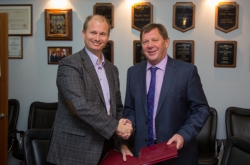What was once science fiction becomes fact
Britain's THE IET AF Harvey Prize is a prestigious international award in the field of engineering research; it is conducted annually by the Institution of Engineering and Technology (IET) - one of the world's largest and most successful engineering institutions. It was awarded for the first time in 2011, with a prize fund of 350 000 GBP; in 2016, Arseniy Kuznetsov from the Data Storage Institute in Singapore received this award for research in the field of dielectric nanophotonics (it studies the behavior and use of light in nanoscale projects). Among other things, his team works on developing a new concept of low-loss dielectric nanoantennas. The concept can be used in several fields: from creating improved devices for medical and telecommunications fields to applying it in VR and AR and developing holographic displays.
According to Sir John O'Reilly, Chair of the IET's Selection Committee for the Prize, "Dr Kuznetsov's research makes science fiction become science fact", and may well lead to explosive growth in the field of creating new products based on nanophotonics and the corresponding markets.
At the same time, Arseniy Kuznetsov noted that this award demonstrates the success of all the research in the field of dielectric nanophotonics for the past several years, as well as the field's promising future.
What problems are dielectric nanophotonics supposed to solve?
To effectively control light, one has to simultaneously and independently control its electric and magnetic components. Yet, there is a problem: the magnetic response of natural materials at optical frequencies is often weak, and photonic devices mainly work with the electric part of the optical wave. Dielectric nanophotonics aims to solve this problem, as it allows controlling both electric and magnetic resonances.
How does it work? According to Arseniy Kuznetsov, most structures with a magnetic response contain metal elements and have high losses at optical frequencies. This naturally limits their performance. Plasmonic nanoantennas are structures based on metals - gold, aluminum, silver, copper. They are almost ideal for working in radio frequency band, but are not good at controlling light on a nanoscale.
 A holographic image created by laser light passing through a metasurface. Wang et al. ©2016 American Chemical Society. Credit: phys.org
A holographic image created by laser light passing through a metasurface. Wang et al. ©2016 American Chemical Society. Credit: phys.org
These limitations affect such applications as sensing. Sensing is a method used in biology and medicine. In almost every biochemical laboratory there are devices based on surface plasmon resonance, that can be used to monitor a chemical reaction on a nanoscale. The plasmon sensors overheat due to losses, which limits the use of sensing: for instance, it is really hard to apply it to small concentrations of temperature-sensitive proteins.
A new approach that can well solve this problem is using dielectric nanoantennaes. These are structures based on materials with low losses - for example, silicon or gallium arsenide. Such materials react to both the electric part of the wave and the magnetic one. Also, the form of the particles allows ranging the responses, which provides for certain flexibility in controlling light.
ITMO University also does research in this field: like Arseniy Kuznetsov, specialists from the Metamaterials Laboratory were pioneers of dielectric nanophotonics. Several years ago, the scientists decided to combine their efforts - ITMO's Center for Nanophotonics and Metamaterials and Data Storage Institute signed a collaboration agreement. As part of this collaboration, scientists exchanged experience and published articles in such renowned journals as Nanoletters, Laser and Photonics Reviews, and Applied Physics Letters.
 ITMO University. Anton Samusev
ITMO University. Anton Samusev
"For the last two years, we worked together as part of our collaboration agreement, and that was not some formal interaction - it was for real. We had six publications, four in renowned international journals," comments Anton Samusev, senior research associate at the Department of Nano-Photonics and Metamaterials.
Now, the Metamaterials Laboratory also conducts research on the optical properties of dielectric silicon metasurfaces that can conduct light in 2D on a potential optical chip. Another highly productive collaboration with DSI's team is on experimental detection of hot spots of magnetic field in dielectric structures. This will allow retifying compounds that are sensitive to magnetic fields at optical frequency more effectively. Taken as a whole, the current projects of the Metamaterials Laboratory have to do with research in the field of amplifying luminescence, non-linear dielectric antennas, hybrid nanoantennas and metasurfaces, and such.
Cameras on a chip and 3D holographic displays - is this possible?
As of now, scientists can create static holograms; developing a holographic display is still something that needs to be done. According to Arseniy Kuznetsov, the next challenge in the field of dielectric nanophotonics will be creating tunable structures, or getting the opportunity to dynamically control the optical properties of each nanoparticle separately. In practice, that will allow to create a display that will show three-dimensional images.
 Interactive holographic display. Credit: habrahabr.net
Interactive holographic display. Credit: habrahabr.net
"We are not talking about the kind of holograms in Star Wars movies, where the image appears in front of the screen. In our case, the hologram will be "inside" your smartphone, but you will see it in 3D format - like in 3D films, though you won't need the glasses. This can be great for the entertainment industry", explains Anton Samusev.
It is also quite possible that we will be able to turn normal window glass into a display - thanks to a special metasurface applied to the glass, the user will have the opportunity to dim his "smart window" or even watch videos on it.
Further research in the field of dielectric nanophotonics will offer opportunities for other fields, as well. For instance, that would be making lenses much thinner, or even creating a camera in the size of a chip.





